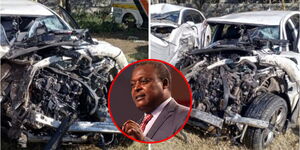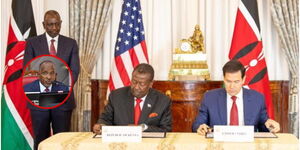Cases of heart attack in Kenya are on the rise, especially among the elderly and Kenyans with pre-existing health conditions.
According to the World Health Organisation (WHO), coronary heart disease deaths in Kenya account for 4.54 per cent of total deaths.
Coronary heart diseases include heart attacks and cardiac arrest.
While many Kenyans use cardiac arrest and heart attack interchangeably, Dr Kelvin Mwendwa, a Diagnostic and Cardiac Radiographer, explained that they are different.
“A heart attack happens when blood flow to the heart is blocked but a cardiac arrest happens when the heart suddenly stops beating,” he explained during an exclusive interview with Kenyans.co.ke.
Symptoms of heart attack
Mayo Clinic lists the symptoms of a heart attack and notes that someone can experience some of the symptoms or all of them.
They include;
Chest pain,
During a heart attack or cardiac arrest, you can feel pressure or tightness in your chest, characterized by a squeezing or aching sensation in the center of your chest.
Breathing difficulties
During the attack, patients experience difficulty in breathing.
“The difficulty in breathing can happen in two ways; the heart can beat fast or low and in the other instance, the person can experience uncontrollable breathing,” Mwendwa revealed.
Body pain
Mayo Clinic details that a patient will experience body pains during a heart attack.
The pain can also be in form of discomfort that spreads to the shoulder, back, jaw, teeth, and upper abdomen.
Other symptoms of heart attack/cardiac arrest include; nausea, indigestion, heartburn, abdominal pain, light-headedness, dizziness, fainting, and sweating.
First Aid in Case of Health Attack
Mwendwa remarked that it is sad that many Kenyans continue to lose their lives due to heart attacks when it is preventable in some cases.
“Many Kenyans especially in the rural areas do not know what to do in case of a heart attack.
“With quick response, it is possible to save the life of a person suffering a heart attack or cardiac arrest,” he told Kenyans.co.ke.
Mwendwa warns that First Aid measures should not be used as a substitute to medical attention.
“Immediately a person has a heart attack, you should call for ambulance service before proceeding to offer First Aid care,” he advises Kenyans.
Mwendwa’s remarks were echoed by Dr Ahmed Kalebi, a renowned consultant pathologist.
Dr Kalebi while commenting on the passing on of former Education Cabinet Secretary George Magoha, lamented why an ambulance was not called immediately.
“I actually found it quite disturbing when I heard the narration of the sequence of events leading to George Magoha’s death.
“I wondered why an ambulance was not called immediately instead of calling his friend Prof Mwanda at (Kenyatta National Hospital (KNH),” Kalebi stated on Wednesday, January 25.
Kalebi further explained when such an incident happens, there is a momentary lack of awareness to call for an emergency ambulance.
“During such emergency situations, an ambulance is inherently quicker/faster than any attempts at self-driving a patient to the hospital.
“This is because the ambulance is better placed to navigate traffic and better equipped to provide emergency care en route as they have well-trained EMT medical staff who are well-equipped to provide advanced resuscitation,” Kalebi added.
After calling for an ambulance, Mwendwa advised that you make sure the patient is in a comfortable position and in light clothing.
“After making sure the patient is comfortable, monitor their breathing, and if unconscious immediately perform Cardiopulmonary Resuscitation (CPR) to enhance blood circulation,” Mwenda advised.
On how to perform CPR, Medline Plus instructs, “Push hard and fast on the center of the person's chest in a fairly rapid rhythm.”
When the person regains consciousness, Mwendwa explaind that you have to ask them about any medication they take.
“This helps you know how to handle the victim and also where to seek help.
“If any medication related to hypertension or Asthma or underlying chest or heart disease and the victim had not taken medication help them take it immediately,” he advises.












